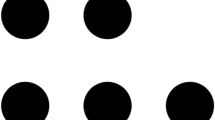Abstract
This paper demonstrates how research-based knowledge about students’ incompatible answers to different representations of the same task could be used in mathematics instruction. The `It's the Same Task' research-based activity is described; this activity encourages students to reflect on their thinking about infinite quantities and to avoid contradictions by using only one criterion, one-to-one correspondence, for comparing infinite quantities. This activity led the vast majority of participants to the realization that producing contradictory reactions to the same mathematical task is problematic and to avoid this contradiction by using the one-to-one correspondence as the unique criterion for the comparison-of-infinite-sets tasks.
Similar content being viewed by others
REFERENCES
A., Tirosh, D. and Nachmias, R.: 1989, ‘Science and mathematics teaching: Interaction between research and practice’, S. Vinner (ed.), Science and mathematics teaching: Interaction between research and practice Jerusalem: Hebrew University, 297–315.
Borasi R.: 1985, ‘Errors in the enumeration of infinite sets’, Focus on Learning Problems in Mathematics 7, 77–89.
J.: 1990, ‘A review of the research on student conceptions in mathematics, science and programming’, Review of Research in Education 16, 3–56.
R.: 1983, ‘L'Obstacle du dédoublement des objets mathématiques’, Educational Studies in Mathematics 14, 385–414.
Even, R.: 1998, ‘Factors involved in linking representations of functions’, The Journal of Mathematical Behavior 17(1), 105–122.
Fischbein, E.: 1987, Intuition in science and mathematics: An educational approach D. Reidel, Dordrecht.
Fischbein, E., Tirosh, D. and Hess, P.: 1979, ‘The intuition of infinity’, Educational Studies in Mathematics 10, 3–40.
Fischbein, E., Tirosh, D. and Melamed, U.: 1981, ‘Is it possible to measure the intuitive acceptance of a mathematical statement?’ Educational Studies in Mathematics 12, 491–512.
Hahn, H.: 1930/1988, ‘Infinity’, in Newman, J.R. (ed.), TheWorld ofMathematics, Tempus Books, Washington, DC, Vol. 3, 1567–1583.
Hart, K. (ed.): 1981, Children's Understanding of Mathematics: 11- 16, Murray, London.
Hitt, F.: 1998, ‘Difficulties in the articulation of different representations linked to the concept of function’, The Journal of Mathematical Behavior 17(1), 123–134.
Janvier, C.: 1987, ‘Representations and understanding: The notion of function as an example’, in Janvier, C. (ed.), Tasks of representation in the teaching and learning of mathematics, Erlbaum, London, 67–71.
Janvier, C.: 1998, ‘The notion of chronicle as an epistemological obstacle to the concept of function’, The Journal of Mathematical Behavior 17(1), 79–103.
Janvier, C., Girardon, C. and Morand, J.C.: 1993, ‘Mathematical symbols and representations’, in Wilson, P.S. (ed.), Research Ideas for the Classroom: High School Mathematics, Macmillan, New York, 79–102.
Johnson, D.J. (ed.): 1989, ‘Children's mathematical frameworks 8- 13: A study of class teaching’, NFER-NELSON, Windsor.
Lesh, R., Post, T. and Behr, M.: 1987, ‘Representations and translations among representations in mathematics learning and problem solving’, in Janvier, C. (ed.), Problems of Representations in the Teaching and Learning of Mathematics, Erlbaum, New Jersey, pp. 33–40.
Martin, G. and Wheeler, M.: 1987, ‘Infinity concepts among preservice elementary school teachers’, Proceedings of the 11th International Conference for the Psychology of Mathematics Education, Montreal, Canada, Vol. 3, 362–368.
Mesquita, A.L.: 1998, ‘On conceptual obstacles linked with external representations in geometry’, The Journal of Mathematical Behavior 17(2), 183–196.
Moreno, A. and Waldegg, G.: 1991, ‘The conceptual evolution of actual mathematical infinity’, Educational Studies in Mathematics 22, 211–231.
Moloney, K. and Stacey, K.: 1997, ‘Changes with age of students' conceptions of decimal notation’, Mathematics Education Research Journal 9(1), 25–38.
Nunez, R.: 1991, ‘A 3-dimensional conceptual space of transformations for the study of the intuition of infinity in plane geometry’, Proceedings of the 15th Conference for the Psychology of Mathematics Education, Italy, Vol. 3, 362–368.
O'Callaghan, B.R.: 1998, ‘Computer-intensive algebra and students' conceptual knowledge of functions’, Journal for Research in Mathematics Education 29(1), 21–40.
Sierpinska, A.: 1994, Understanding in Mathematics, Falmer, London.
Sierpinska, A.: 1987, ‘Humanities students and epistemological obstacles related to limits’, Educational Studies in Mathematics 18, 371–387.
Silver, E.A.: 1986, ‘Using conceptual and procedural knowledge: A focus on relationships’, in Hiebert, J. (ed.), Conceptual and Procedural Knowledge: The Case of Mathematics, Erlbaum, Hillsdale, NJ, pp. 181–198.
Stavy, R. and Tirosh, D.: 2000, How Students (Mis-)Understand Science and Mathematics: Intuitive Rules, Teacher College Press, New York.
Swan, M.: 1983, Teaching Decimal Place Value. A Comparative Study of ‘Conflict’ and ‘Positive Only’ Approaches, University of Nottingham, Shell Centre Nottingham, England.
Tall, D.: 1990, ‘Inconsistencies in the learning of calculus and analysis’, Focus on Learning Problems in Mathematics 12, 49–64.
Tall, D. (ed.): 1991, Advanced Mathematical Thinking, Kluwer, Dordrecht, The Netherlands.
Tirosh, D.: 1990, ‘Inconsistencies in students' mathematical constructs’, Focus on Learning Problems in Mathematics 12, 111–129.
Tirosh, D.: 1991, ‘The role of students' intuitions of infinity in the teaching of the Cantorian theory’, in Tall, D. (ed.), Advanced Mathematical Thinking, Kluwer, Dordrecht, The Netherlands, pp. 199–214.
Tirosh, D. and Tsamir, P.: 1996, ‘The role of representations in students' intuitive thinking about infinity’, International Journal of Mathematics Education in Science and Technology 27, 33–40.
Tsamir, P. and Tirosh, D.: 1992, ‘Students' awareness of inconsistent ideas about actual infinity’, Proceedings of the 16th Annual Meeting for the Psychology of Mathematics Education, Durham, USA, 3, pp. 90–97.
Tsamir, P. and Tirosh, D.: 1994, ‘Comparing infinite sets: intuitions and representations’, Proceedings of the 18th Annual Meeting for the Psychology of Mathematics Education, Lisbon, Portugal, Vol IV, pp. 345–352.
Tsamir, P. and Tirosh, D.: 1999, ‘Consistency and representations: The case of actual infinity’, Journal for Research in Mathematics Education 30(2), 213–219.
Tsamir, P.: 1994, Promoting students consistent responses in respect to their intuitions of actual infinity, unpublished doctoral thesis, Tel-Aviv University.
Tsamir, P.: 1999, ‘The transition from comparison of finite to the comparison of infinite sets: Teaching prospective teachers’, Educational Studies in Mathematics 38, 209–234.
Author information
Authors and Affiliations
Rights and permissions
About this article
Cite this article
Tsamir, P. When `The Same' is not perceived as such: The case of infinite sets. Educational Studies in Mathematics 48, 289–307 (2001). https://doi.org/10.1023/A:1016034917992
Issue Date:
DOI: https://doi.org/10.1023/A:1016034917992




